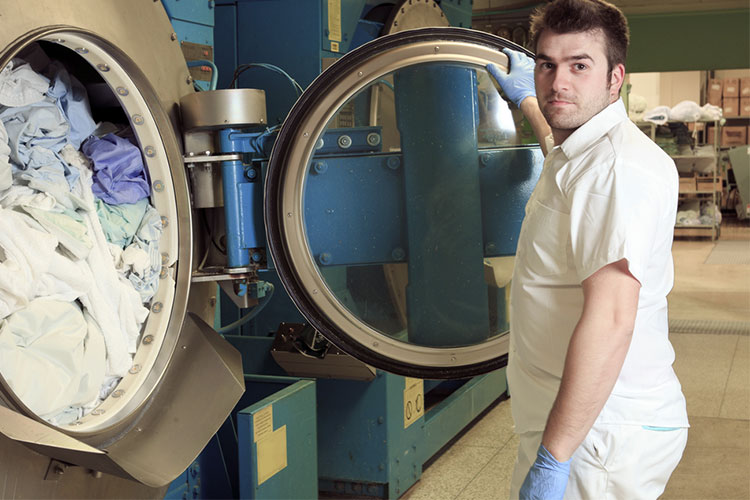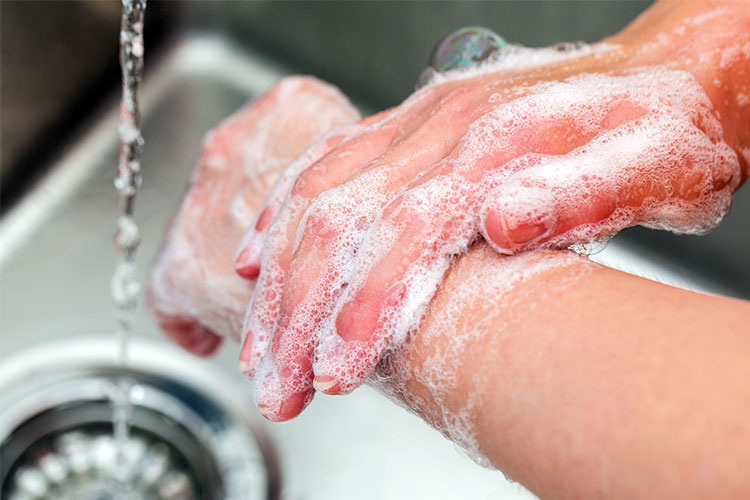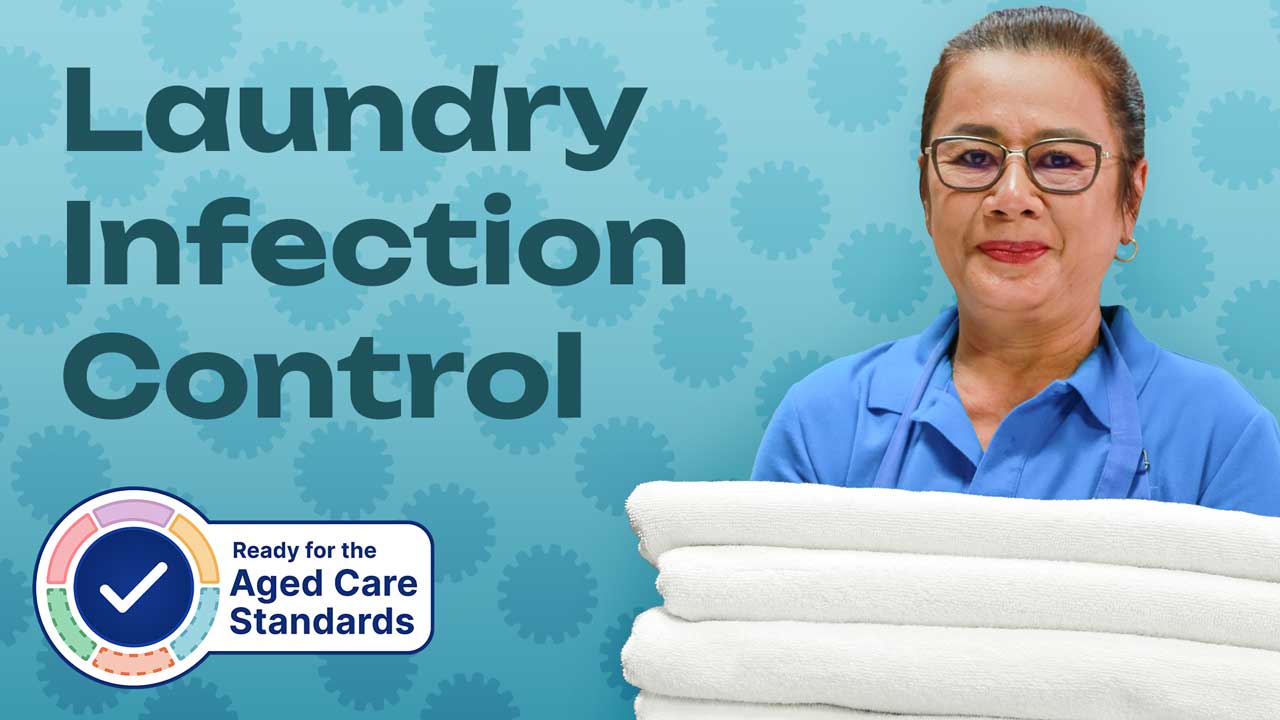Correct laundry procedures are vital to infection control in aged care facilities.
Ensuring that your facility meets and upholds laundry hygiene standards is crucial for the health of residents, staff, and visitors. Proper handling of laundry also lets the families of residents know that their loved one is being well looked after (Dependable Laundry Solutions 2024).
Laundry Services
Providing laundry services is one of the many daily living activities that you may be required to perform or assist with.
Laundry in an aged care setting may include:
- Bedsheets and blankets
- Towels
- Residents’ personal clothing
- Staff uniforms.
(CDC 2015)
As highlighted by an article in The Conversation, the state and condition of a resident’s clothing speak volumes about the care that exists (or doesn’t) in an aged care facility. Clothes are a way to convey a resident’s individuality in a period of their life where it might otherwise feel under threat (Armstrong 2018).
Additionally, laundry and linen can carry traces of influenza, gastroenteritis or other harmful pathogens. As we age, our immune systems weaken. Aged care residents, many of whom are living with pre-existing illnesses, are particularly vulnerable to infection (Dependable Laundry Solutions 2024). This is why properly washing and storing laundry is so important and a key component of a greater infection prevention and control strategy.
Your facility will have its own policies on the proper handling of linen and laundry. Familiarise yourself with those and use this article as a supplement or refresher.
In Australia and New Zealand, there are official regulations in place detailing the proper handling of linen and laundry. While there may be some variations, public healthcare-operated laundry and linen services’ policies must line up with AS/NZS 4146 Regulations (Dependable Laundry Solutions 2024).

Laundry Infection Control Under the Strengthened Aged Care Quality Standards
Standard 4: The Environment - Outcome 4.2: Infection prevention and control under the strengthened Aged Care Quality Standards (Action 4.2.1) requires aged care providers to implement an infection prevention and control system that outlines appropriate standard and transmission-based precautions - this includes safe linen handling (ACQSC 2024; RACGP 2023).
Laundry Infection Risks
Environments where living and non-living microorganisms exist and thrive (including pathogens) are referred to as reservoirs (ACSQHC 2023).
Laundry is a type of fomite - an inanimate reservoir that has the potential to carry pathogens on its surface (ACSQHC 2023).
Contaminated laundry often contains high numbers of microorganisms from body substances such as blood, skin, stool, urine, vomitus and other body tissues and fluids (CDC 2015).
Why do aged care facilities present particular hazards to the cleaning and maintaining of laundry?
Residential aged care, like other types of communal living, increases the likelihood of contact between people, and consequently, the risk of spreading infection. When residents have difficulty with daily living activities such as toileting, this only increases the risk of infection further (DoHaA 2013).
Some residents receiving high levels of care who are in a weakened or non-ambulant state may lie in bed for prolonged periods of time, providing perfect conditions for pathogens to thrive. (Infection Control Today 2005). In cases such as this, more frequent washes will be required.
Furthermore, due to any number of reasons, an aged care resident may have soiled their clothes, and this will require more intensive washing procedures.
Simple Steps to Meet Laundry Standards
The Laundry Process
The antimicrobial action of the laundering process is the outcome of a combination of mechanical, thermal, and chemical factors. Laundry items used in healthcare settings are disinfected during laundering and are generally free of pathogens, but are not sterile (CDC 2015).
Laundering cycles consist of:
- Flush
- Main wash
- Bleaching
- Rinsing
- Souring.
Cleaned linen is then:
- Dried
- Pressed
- Folded
- Packaged.
(CDC 2015)
Safety Guidelines When Handling Soiled Linen or Clothing

Note: Refer to your organisation’s policies and procedures regarding linen disposal.
Used linen is potentially contaminated, so always ensure you store and handle dirty linen in a way that minimises the risk of cross-contamination between clean and used items (WACHS 2022).
Appropriate personal protective equipment (PPE) should always be worn during the handling of any soiled linen.
- Don appropriate PPE (depending on the situation).
- Take an appropriate laundry receptacle to the resident’s bedside. Place their used linen directly into the receptacle without temporarily putting it on floors, chairs or furniture. Avoid shaking linen at the risk of spreading harmful microorganisms.
- Immediately place all soiled linen (e.g., contaminated by blood, urine or other body fluid) into a leak-proof bag. Ensure that you keep soiled linen away from your clothes/uniform.
- Avoid sorting or rinsing used linen in resident care areas.
- Perform proper and thorough hand hygiene after handling used linen.
- Store linen in a clean, dry area that is separate from used linen and free of aerosols, dust, moisture, or vermin that could cause contamination.
(DoHaA 2013; WACHS 2022; Dependable Laundry Solutions 2024)
In order to avoid accidental exposure to soiled linen:
- Never place sharps or other objects into laundry bags, as these may break the bag and cause leakage.
- Avoid filling laundry bags more than ¾ full or over 15 kg.
(WACHS 2022)
Test Your Knowledge
Question 1 of 3
How should laundry be stored after it has been cleaned and dried?
Topics
Further your knowledge

 Free
Free Free
FreeReferences
- Aged Care Quality and Safety Commission 2024, Standard 4: The Environment, Australian Government, viewed 9 May 2024, https://www.health.gov.au/resources/publications/strengthened-aged-care-quality-standards-august-2025?language=en/environment
- Armstrong, P 2018, ‘When Choosing a Nursing Home, Check the Clothing and Laundry’, The Conversation, 15 August, viewed 8 May 2024, https://theconversation.com/when-choosing-a-nursing-home-check-the-clothing-and-laundry-100727
- Australian Commission on Safety and Quality in Health Care 2023, Infection Prevention and Control Workbook, Australian Government, viewed 8 May 2024, https://www.safetyandquality.gov.au/publications-and-resources/resource-library/infection-prevention-and-control-workbook-2023
- Centers for Disease Control and Prevention 2015, Background G. Laundry and Bedding, U.S. Department of Health & Human Services, viewed 8 May 2024, https://www.cdc.gov/infectioncontrol/guidelines/environmental/background/laundry.html#g4
- Dependable Laundry Solutions 2024, Aged Care Laundry Guidelines, Dependable Laundry Solutions, viewed 8 May 2024, https://www.dependablelaundry.com.au/aged-care-laundry-guidelines/
- Department of Health and Ageing 2013, Prevention and Control of Infection in Residential and Community Aged Care, Australian Government, viewed 8 May 2024, https://www.dss.gov.au/sites/default/files/documents/10_2014/d1034_pocket_book_d13-1522052.pdf
- Infection Control Today 2005, ‘How to Handle Contaminated Linens’, Infection Control Today, 1 August, viewed 8 May 2024, https://www.infectioncontroltoday.com/view/how-handle-contaminated-linens
- The Royal Australian College of General Practitioners 2023, ‘Standard Precautions’, Infection Prevention and Control Guidelines, viewed 9 May 2024, https://www.racgp.org.au/running-a-practice/practice-standards/racgp-infection-prevention-and-control-guidelines/5-levels-of-precaution/standard-precautions
- WA Country Health Service 2022, Linen Management Procedure, Government of Western Australia, viewed 8 May 2024, https://www.wacountry.health.wa.gov.au/~/media/WACHS/Documents/About-us/Policies/Linen-Management-Procedure.pdf?thn=0

